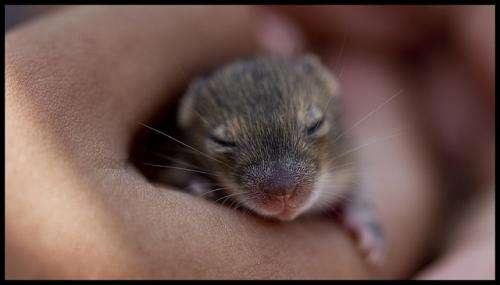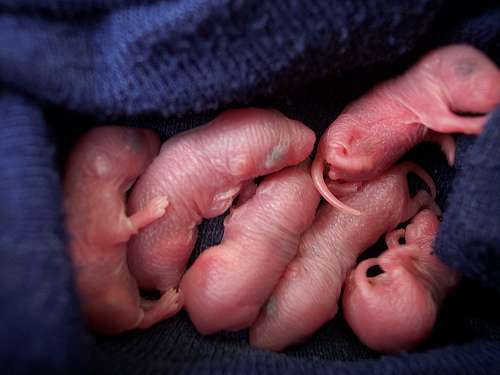Mice nest together to confuse paternity and reduce infanticide

It is a cruel world out there, particularly for young animals born into social groups where infanticide occurs. This dark side of evolution is revealed when adults – often males – kill offspring to promote their own genes being passed on, by reducing competition for resources or making females become sexually receptive more quickly.
This behaviour proves expensive for females, who have evolved strategies to avoid this fate. One strategy is to join forces with other females to physically ward off killer males. A more interesting strategy is to mate with several males, known as "polyandry", so fathers can't distinguish their young from others', which means they avoid killing pups so that they don't accidently kill their own.
Now, researchers at the University of Zurich have found a new type of infanticide counter-strategy: mothers can achieve paternity confusion even if they don't mate with multiple males, through nesting with other females, which they call "socially mediated polyandry". And such a strategy might be happening close to home, in the unassuming house mouse.
Yannick Auclair and his colleagues put their theory to the test on a wild population of mice living in an old agricultural building outside Zurich. They measured the genetic relationships within litters and found a complex picture of female social relationships and mating patterns. These allowed them to identify mothers nesting alone or with others and those who mated with one or more males. To examine the risk of infanticide for pups born into these different types of litters, they assessed survival until just before weaning, which is about two weeks after birth.
Direct observations of infanticide are extremely rare in natural systems. But studying an enclosed population without the presence of a predator meant that infanticide becomes the most likely cause of death for young pups. And indeed, from the corpses of pups that were recovered, most gave direct evidence – missing limbs or holes in the skull – of this harsh fate.
The results of the study were published in the journal Behavioral Ecology. The researchers found that pups born to females nesting alone and who had only one mate had the lowest survival rate (50% surviving, the rest presumably killed by males who were confident they were not the father). Meanwhile, those born to females nesting together were better off (80% surviving).

Key evidence supporting their theory was that some of these communal litters were composed of pups whose mothers had actually only mated once, but the different females had different mates. These litters had similar survival to those where paternity was mixed for individual mothers, suggesting that mothers can achieve the same survival benefits of communal nesting without mating with multiple males.
There were also a few communal litters (nine of the 90 studied) where the different females had mated with the same male and, as such, featured multiple mothers but no paternity confusion. These litters had worse survival rate (40% surviving) suggesting that – as predicted by the theory – paternity confusion is a more important driving factor of communal nesting than the physical warding off of males.
According to Elise Huchard of CNRS Montpelier: "This study presents an interesting idea, and an interesting system to test it." Yet the data raise more questions than they answer – and additional experiments or comparative work would be insightful.
For example, it is not clear whether higher survival in litters with multiple fathers might actually reflect variation among females if, as in the case of mouse lemurs, higher-quality females have more mates. Dieter Lukas of Cambridge University concurs that the theory is interesting, but believes it is too early to assess its generality.
Infanticide occurs across diverse mammal systems – from meerkats and rabbits, to lions and gorillas – and comparative analyses could help assess how this theory fares among the many hypotheses about the evolution of infanticide.
Communal nesting may have evolved as an alternative to mating with multiple mates (which is costly when males harass females during mating or transmit disease) as a strategy to avoid infanticide through paternity confusion. "We don't know whether other social behaviours may have evolved through similar ways," said Auclair.
Comparative analyses will lead to new insights and future research on the nest-box population will also address such interesting questions as how females choose their nesting partners – and why some still nest alone even if this comes at a cost to offspring survival.
Then mice can join meerkats in the legion of apparently cute mammals with sinister strategies up their sleeves to ensure their evolutionary success.
Journal information: Behavioral Ecology
Source: The Conversation
This story is published courtesy of The Conversation (under Creative Commons-Attribution/No derivatives).
![]()



















